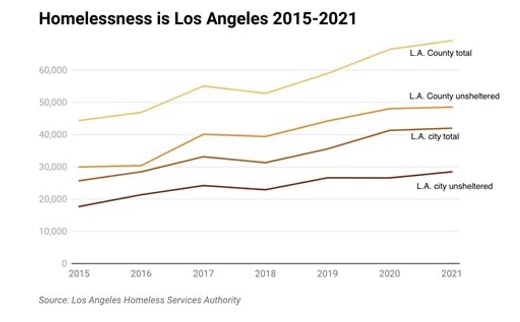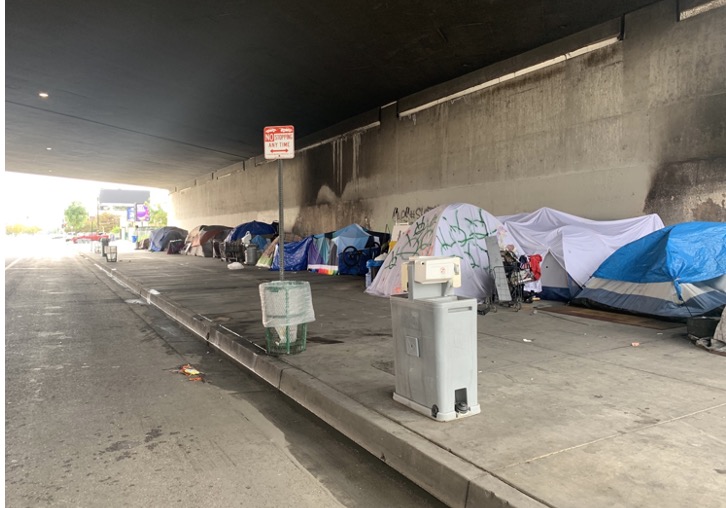CommentsPLANNING WATCH - The new 2022 LA City and LA County homeless census is now available from the Los Angeles Homeless Services Authority (LAHSA).
In February of this year approximately 69,000 people were homeless in Los Angeles County and 42,000 in the city of Los Angeles. Countywide the homeless population increased by 4.1 % over 2020 and 25.9 % since 2018-2020. In the city the numbers were similar, a 1.7 % increase from 2020 and a 32% increase from 2018-2020.

According to Molly Rysman, LAHSA’s Acting Co-Director:
“Tenant protections and rental assistance helped people stay in their homes and out of homelessness. But now our community is in a precarious position. If these policies end, it is entirely possible that future homeless counts could show significant increases. We need those critical policies (e.g., one time Federal assistance, eviction moratoria, rental assistance) to continue.”
Why any knowledgeable public official or journalist should have expected different results is hard to fathom, unless their forte is packaging grim news in a flattering light, like claims that homelessness has declined in a small geographic area?
No one should be surprised by this increase in homelessness in Los Angeles. The following is a partial list of actions that Federal, state, and local officials could have taken to alleviate the housing crisis but did not. Until they do so, City Hall’s fallback position of anti-camping ordinances and police sweeps to placate fed-up constituents will escalate.
- Has the U.S. Congress restored the HUD public housing programs they incrementally abolished, beginning with the Nixon administration in the early 1970s? No, the only form of publicly subsidized housing that remains is Section 8, and it is severely underfunded. While LA has no shortage of private and public parcels that could sprout new public housing, without the reactivation of Federal government public housing programs, the housing crisis will get worse.
- Has the California State Legislature restored the subsidized public housing role of the Redevelopment Agencies they dissolved in 2012? This important funding source for public housing disappeared a decade ago.
- Have wage levels been increased in order to offset growing economic inequality, a major cause of homelessness in LA? As of July 2022, LA’s minimum wage is $16/hour, while the average hourly wage is $24/hour. Neither figure accounts for rampant wage theft, and both figures are far below the $39/hour wage required to rent a typical LA apartment within 30 percent of household income.
- Did the LA City Council support the Costa-Hawkins repeal initiative that would have allowed the LA’s Rent Stabilization Law to include apartments built between 1978 to 1995? The Los Angeles City Council took no action, even though this change to LA’s Rent Stabilization Ordinance would have benefited tens of thousands of tenants at risk of becoming homeless.
- Did the LA City Council support the end of the Vacancy Decontrol loophole in LA’s Rent Stabilization Ordinance? When a rent stabilized apartment is vacated, landlords can charge whatever the market will bear, regardless of the previous rent. The ballot initiative to rescind the Costa-Hawkins law would have changed this, but unlike other cities, the LA City Council took no action.
- Has the LA City Council upgraded enforcement of the city’s Short-term Rental Ordinance? It is still in the hands of LA City Planning, an agency that has no enforcement authority or experience. This is the main reason why so much housing in LA is illegally rented to tourists at exorbitant rates that local residents cannot afford.
- Did LA’s Housing Department establish a registry of LA tenants whose low incomes qualify them for low-rent housing ? Landlords are still on their own in screening prospective tenants for these affordable units, while the parallel Housing Department registry of available low-rent housing is filled with errors.
- Does the Housing Department inspect low-income apartments promised by developers in exchange for density bonuses? In LA landlords and developers are still on the honor system when City Hall grants them density bonuses for pledging to include low-income units in their new up-scale apartment buildings. No City employees ever make a physical inspection to verify these units and their tenants.
- Has the Department of City Planning’s Housing Progress Dashboard been revised to measure low income apartments that have received a certificate of occupancy and then rented to vetted low income tenants? City Planning’s on-line data only lists building permits issued, not low-income apartments built and then leased to verified low-income tenants.
- Does LA’s Department of Building and Safety enforce anti-mansionization ordinances after the City Council adopts them? Except for neighborhoods protected by Historical Preservation Overlay Zones, the remaining 90 percent of Los Angeles neighborhoods are being steadily mansionized, even those with anti-mansionization RFA ordinances. In these areas developers continue to demolish starter homes by the thousands and replace them with McMansions. These new supersized houses are not only replete with code violations, but this process replaces existing lower-priced housing with new, expensive residences that few Angelenos can afford.
- Has the Los Angeles City Planning Commission and the City Council set higher bars for granting General Plan Amendments, Zone Changes, Zone Variances, and other discretionary actions that legalize previously illegal projects? No, in Los Angeles decision makers approve 90 percent of discretionary land use applications. The zones and plans designations assigned to every parcel through Community Plan Updates are all subject to pay-to-play negotiations. This results in the construction of new, expensive, previously illegal apartments that the homeless, over-crowded, and cost-burdened cannot afford.
Because the main causes of the housing crisis have remained intact in Los Angeles (and elsewhere), no one should be surprised by the steady increase in homelessness. What they should be surprised about is the amazing ability of elected officials and the media to frame the housing crisis as a strictly local issue, even though the main causes (#’s 1, 2, and 3 above) are statewide and nationwide.
( Dick Platkin is a former Los Angeles city planner who reports on local planning issues for CityWatchLA. He serves on the boards of United Neighborhoods for Los Angeles (UN4LA) and the Greater Fairfax Residents Association. Previous Planning Watch columns are available at the CityWatchLA archives. Please send comments and corrections to rhplatkin@gmail.com.)
















